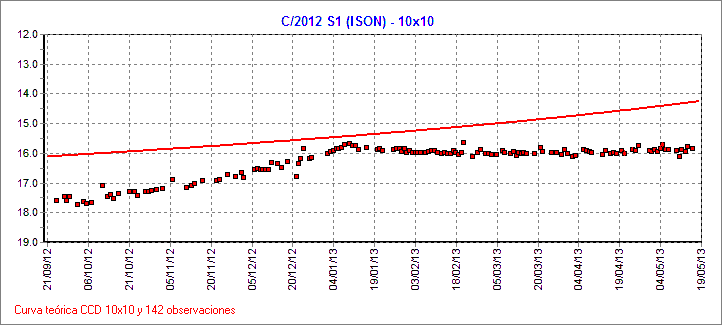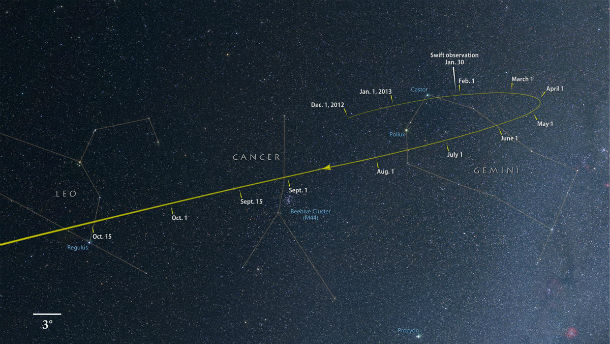Has Comet ISON stopped brightening?
Comet ISON is expected to become one of the most dazzling skywatching events while making a passage around the Sun later this year. In October of 2012 NASA's Jet Propulsion Laboratory (JPL) stated that Comet ISON (C/2012 S1) could reach magnitude -11.6, which is almost as bright as the full Moon. If JPL`s prediction comes true the comet would shine so bright that it would cast shadows at night, and would be bright enough to easily be spotted during broad daylight.

Images of Comet ISON obtained using the Gemini Multi-Object Spectrograph at Gemini North on February 4, March 4, April 3, and May 4, 2013 (left to right, respectively; Comet ISON at center in all images). (Credit: Gemini Observatory/AURA/Color composite produced by Travis Rector, University of Alaska Anchorage)
Based on comet's orbit, astronomers belive the comet is coming from Oort cloud, making its first visit to inner solar system. ISON was discovered on September 21, 2012, by Russian astronomers Vitali Nevski and Artyom Novichonok using a telescope of the International Scientific Optical Network (ISON) located near Kislovodsk, Russia.
But things are looking pretty grim for now as the comet has supposedly stopped brightening since the beginning of 2013.
According to comet hunter John Bortle, Comet ISON is not evolving as earlier predicted. ISON has stagnated as near 16th magnitude for a couple of months now. The coma's degree of condensation grew quite strong, and soon after an unexpected strong but short tail that has appeared and it persists right down to today. The coma subsequently faded and became less condensed and smaller.

Faustino Garcia created this graph using CCD camera, where the solid red line shows the original brightening forecast for C/2012 S1(ISON)
Since comet ISON probably originates from the icy Oort cloud it has not yet been exposed to the effects of the sun. ISON might have a thin layer of frosted material around it which could vaporize at a great distance from the sun, affecting the comet's brightness. This might be the case with ISON.
Experts will not be able to say what will actually happen with ISON until the comet gets close enough to the sun, when any frozen water inside it`s 4.8 km wide nucleus will begin to sublimate. This will occur in a period between July 8 and August 12, 2013 when the comet is suppose to fly within 450 million to 370 million km of the sun, and then ISON might start to brighten again. C/2012 S1(ISON) is currently approaching the 50,000 mph mark at a distance of 330.1 million miles from the Sun. There are still 184 days until perihelion.
Remember that comets are famously unpredictable and ISON is no different, so as the comet gets closer more accurate predictions will be available.

From now through October, comet ISON tracks through the constellations Gemini, Cancer and Leo as it falls toward the sun. (Credit: NASA's Goddard Space Flight Center/Axel Mellinger)
Comet ISON will pass very near Regulus in constellation Leo on October 14/15, 2013 and near Spica in mid-November. On November 23, 2013 ISON will pass very near a planetary pair of Mercury and Saturn and on November 28, 2013 Comet ISON will be at closest point to the Sun. It will be visible on both evening and morning skies for mid-Northern observers and circumpolar for the far North through December. ISON makes its closest approach to Earth at 39.6 million miles on December 26, 2013.
Source: NASA, CometISON2013, Space.com
Featured image: NASA’s Hubble Space Telescope provides a close-up look of Comet ISON (C/2012 S1), as photographed on April 10, when the comet was slightly closer than Jupiter’s orbit at a distance of 386 million miles from the sun. (Credit:NASA, ESA, J.-Y. Li /PSI/Hubble Comet ISON Imaging Science Team)

Stopped brightening? Sweet dreams NASA. This Thunderball will Rock us!
According to some amateur sources, the comet is at magnitude 14.84 as of the 18th of May and brightening? Two months ago it was at magnitude 15.6 so that's an increase of around 4 or 5%? Is the data I have wrong or is this brightening insignificant? Taking into account its distance from the sun and how bright it is already I think the real show will begin soon?? I am really looking forward to this comet and the possible show that maybe remembered in history books!